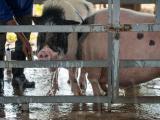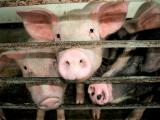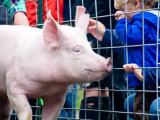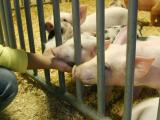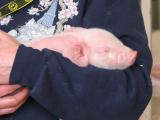Aug 21, 2012 (CIDRAP News) – The type of flu transmission occurring mainly in young people directly exposed to pigs at fairs this summer is unprecedented, and health officials should consider keeping pigs away from the events, according to one infectious disease expert who has gone on record with his concerns.
As Minnesota announced its first confirmed and suspected variant H3N2 (H3N2v) infections yesterday, just a few days before the start of its state fair, local and national media outlets such as the Canadian Press aired concerns from Michael Osterholm, PhD, MPH, director of the University of Minnesota's Center for Infectious Disease Research and Policy (CIDRAP), publisher of CIDRAP News, who said that fair organizers should bar swine from fairs this year.
Osterholm told CIDRAP News that health officials are watching a dynamic influenza situation unfold that hasn't been seen in about 80 years. Further, he said, the chance of virus mutations could increase if human-to-human transmission occurs, potentially leading to a human strain that could pose a significant health threat.
The mild nature of the infections that have been reported so far and the small number of people infected, compared with the millions who have attended fairs this summer, don't offset concerns about virus reassortment, Osterholm said. The infections surfacing in kids may be an artifact of who's spending a lot of time in swine barns and could reflect that children are more likely to be tested for flu than adults, he added.
He said a stronger scientific basis is needed for some of the interventions that have been suggested to reduce the risk of H3N2v infection at fairs. For example, he pointed to recent findings that many pigs with influenza are asymptomatic, so relying on screening the animals at fairs isn't an effective way of keeping infected animals out of swine barn settings.
Also, he said that health department and federal guidance suggesting frequent hand washing to prevent flu transmission after contact with swine may seem like a sensible approach that works against other types of infections, but that there are no data to support its effectiveness for curbing flu transmission. "The idea of telling people to wash their hands is at the very least misleading," he said.
Barring swine from fairs would be a tough call, given the work people put into raising the animals for show and the popularity of swine barns among fairgoers, but, Osterholm said, "Public health is not easy, and that's not a reason to not base responses on the best science."
In the wake of Osterholm's comments yesterday, health officials are still assessing the risks but have not made the decision to bar swine from fairs.
Richard Danila, PhD, MPH, deputy state epidemiologist at the Minnesota Department of Health (MDH), told CIDRAP News that his department had a call this morning with officials at the US Centers for Disease Control and Prevention (CDC) to touch base about the risks and recommendations. A few people have gotten sick with H3N2v infections after being in swine barns, but health officials feel additional measures, such as urging people at risk for flu complications to avoid the barns, is proportional to the risk, he said.
Though the risk the virus poses is a big question mark, public health officials routinely operate in an environment with unknown factors, Danila said, noting that H3N2v could circulate in swine populations for a long time. "We are going to monitor the situation closely," Danila added.
The CDC has issued an advisory for fairgoers on preventing flu transmission between pigs and people and has not recommended that states cancel pig exhibitions. In updated information yesterday, the agency repeated its warning that people at risk for flu complications, such as pregnant women and people with underlying health conditions, avoid swine barns at fairs this year.
Tom Skinner, a spokesman for the CDC, said the agency is emphasizing personal protective measures people can take if they come in contact with pigs that are known to be or suspected of being sick, such as wearing protective clothing, gloves, and masks. The CDC's advisory also urges animal handlers with flulike symptoms to avoid being around pigs or, if that is not possible, to use personal protective gear when working with them.
The CDC has said it is concerned about the risk of human-to-human spread, given that this occurred on a limited basis in some 2011 infections and that the virus contains the matrix gene of the 2009 H1N1 virus, which could make it more transmissible. Yesterday CDC issued guidance urging school administrators to be on the lookout for kids with flulike symptoms, and today it updated its surveillance advice for public health departments.
With the increasing number of cases, CDC urged states to consider increasing surveillance to include testing of specimens from Influenza-like Illness Surveillance Network (ILINet) providers and those collected from people who have unusual or severe flulike illnesses. The CDC also asked states to consider collecting samples from flulike illness outbreaks in childcare settings and schools, which have been linked to person-to-person H3N2v transmission in the past.
In other developments today, England's Health Protection Agency (HPA) issued an update on the American H3N2v cases and urged health practitioners to flag flulike illnesses in returning travelers who became ill after contact with pigs in the United States. It said the virus hasn't been detected in pigs or humans in the United Kingdom.
The HPA said the threat to the UK is low, but it is keeping in contact with US health officials to remain aware of any changes. Dr. Nick Phin, with the HPA's influenza department, said in the statement, "We are reassured that there is little evidence to support human to human spread and that virtually all of the cases can be associated with direct contact with pigs."
See also:
Aug 21 Canadian Press story
Aug 21 Star Tribune story
Aug 21 follow-up Star Tribune story
Aug 20 CDC advisory for preventing the spread of flu between people and pigs at fairs
Aug 20 CDC updated interim guidance on H3N2v surveillance
Aug 21 HPA statement
